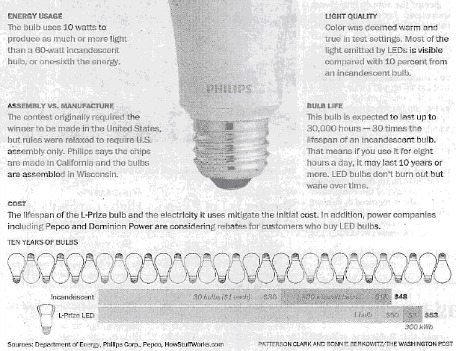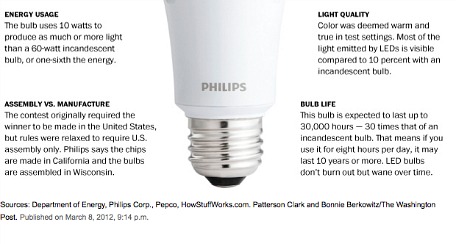New Mexico Senator Jeff Bingaman’s office this afternoon sent out a press release hammering the Washington Post‘s page-one story on the high cost of the LED light bulb that just won a government prize. Bingaman’s right.
First, the Post doesn’t take into account the savings consumers can expect from an LED bulb over its lifetime compared to using incandescents. Second, it’s probably a bit much to call it “government-subsidized” in the headline when it was developed without government money. Third, a graphic illustrating the story uses incorrect data that says incandescent bulbs cost less than they really do.
Finally, the Post has removed the offending information from its infographic online without posting a correction or otherwise noting anything has changed.
(Let me disclose that my wife works in energy efficiency, though she deals with the industrial sector.)
Here’s the deal: To spotlight LEDs and help speed their development, the Energy Department created a contest called the L Prize, which would award $10 million to the best affordable LED replacement for a 60-watt incandescent bulb.
Philips won the contest with its LED that uses 10 watts of power to kick off the same amount of light as a 60-watt incandescent.
Here’s the Post‘s top:
The U.S. government last year announced a $10 million award, dubbed the “L Prize,” for any manufacturer that could create a “green” but affordable light bulb.
Energy Secretary Steven Chu said the prize would spur industry to offer the costly bulbs, known as LEDs, at prices “affordable for American families.” There was also a “Buy America” component. Portions of the bulb would have to be made in the United States.
Now the winning bulb is on the market.
The price is $50.
Fifty bucks? Ouch. It’s a lot of money to pay upfront for a light bulb.
But let’s look at some context, which the Post skims over in its story (a line stuffed in the eighteenth paragraph that says “The new bulbs can cut energy costs by more than 75 percent,” but doesn’t quantify what that means), and which it messes up in its graphic.
According to the Post‘s own infographic, the LED is projected to last as long as thirty incandescent light bulbs. At 60 cents a pop, that knocks $18 off the LED’s premium over its lifetime.
And, of course, the whole point of super-efficient lighting is to use much less energy, which isn’t an upfront cost but one that accumulates over time. Bingaman’s office calculates that at 11 cents a kilowatt-hour, Philips’s LED will use about $33 worth of electricity over its lifetime, compared to $198 for incandescents.
That means that $50 bulb will actually cost $133 less than using 60-cent incandescents, plus it will produce far less carbon and other pollutants as a bonus (and perhaps as additional cost savings if there’s ever a carbon tax). And that’s just what the bulb costs now. As LED production ramps up, those costs will go way down.
Bingaman’s office also notes that the Post used erroneous energy costs to calculate the lifetime cost of a bulb. The Post‘s graphic implies electricity costs just 1 cent per kilowatt-hour, but the national average is 12 times as much, or 11.8 cents per kilowatt-hour. If you live in New York City, you pay some 26 cents per kilowatt-hour, meaning the LED would save you twice as much. Here’s the original graphic:
Here’s what the Post has on its website now:
It’s good that the Post fixed this. It’s not good that it didn’t flag it to readers.
On the bigger picture, though, you can of course ask why the government is in the business of spending $10 million on a prize to build superefficient light bulbs. And you can say that the upfront cost of such a bulb makes it unaffordable—it clearly does for many or most people. And it’s fair to ask whether the extra few watts this LED saves is worth the extra cost.
But you can’t elide the total cost savings such a bulb will ultimately deliver, especially when that’s its reason for being.
UPDATE: The Post has corrected its graphic, but doesn’t flag the correction to readers.
Ryan Chittum is a former Wall Street Journal reporter, and deputy editor of The Audit, CJR’s business section. If you see notable business journalism, give him a heads-up at rc2538@columbia.edu. Follow him on Twitter at @ryanchittum.


